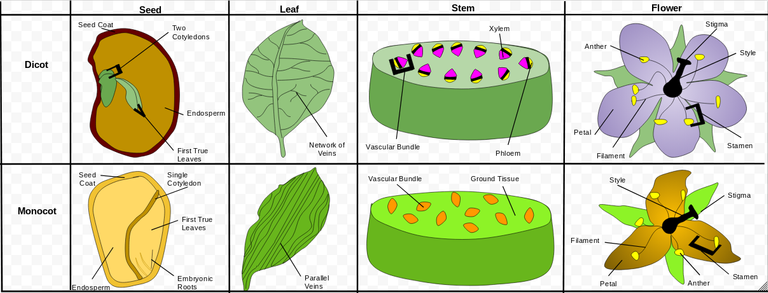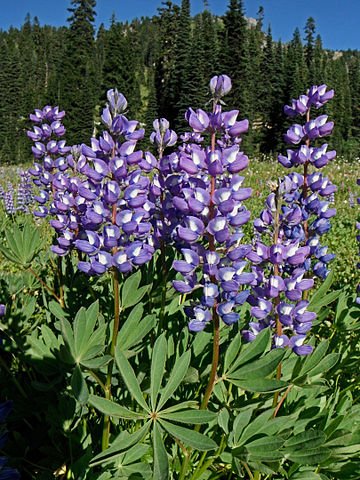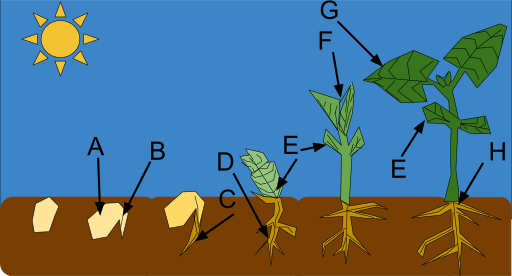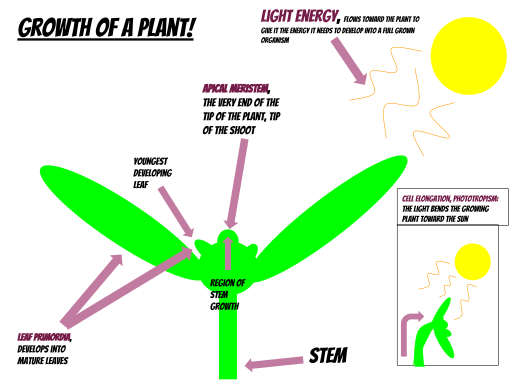HOW PLANTS GROW AND RESPOND (II)
Hello, great readers. In my previous post I discussed about hormones and the plant growth substances such as auxins, gibberellins, cytokinins, ethene and the abscisic acid. And in the end of that post I promised that in my next post I would dicuss more on the life of plants; starting with what a seed is, its dormancy, how they germinate, and finally on the movement and growth of plants etc. Yeah, that’s basically what I will be writing on today. Why don’t you ride on with me?
THE LIFE OF PLANTS
In this section, I will look at the development and growth of a plant from seed to flower.

A seedling. Image by Sarah Richter from Pixabay
So, what is a seed?
A seed is similar to an egg in many ways: both contain an embryo organism together with a food store inside a protective coat. The figure below shows the basic features of a seed:
- The testa – the protective seed coat. This varies from a thin membrane to something as tough as a brazil nut.
- The cotyledons – or seed leaves rather than true leaves, though they do develop into ‘proper’ leaves in some species. In some species, the seed leaves contain the food reserves. As their names suggest, seeds of monocotyledons have one cotyledon, while those of the dicotyledons have two.
- The endosperm – a separate tissue that contains the food reserves to nourish the embryo. The aleurone layer is the metabolically active outer layer of the endosperm.
- The Embryo. This has two parts: the plumule (young shoot) and the radicle (young root).
- The micropyle – a tiny hole just above the point where the seed was attached to the fruit. This is the main site of water entry.
There are many different types of seed. Some, e.g. broad bean, are nourished by starch in two large cotyledons, but there is no endosperm. In monocotyledons such as wheat, the single cotyledon is a small flat structure and the embryo is nourished by the starchy endosperm. Flour, and all of the products made from it, is basically squashed endosperm.
A third seed type is shown by the castor oil seed, which has two small seed leaves (it’s a a dicot) and the food store consists of an oily endosperm.

Comparison of monocotyledons and dicotyledons. C. Hulme Taylor, CC BY-SA 4.0
SEEDS AND DORMANCY
Seeds need water, oxygen and a suitable temperature before they can germinate. There are some seeds, however, than won’t germinate even when given these conditions. Such seeds have evolved delaying tactics to ensure that they don’t germinate at the wrong time, e.g. in the autumn, with little chance of surviving the winter, or during a dry season. Seeds can remain dormant for hundreds or even thousands of years. The present record is held by the arctic lupine. Its seeds may land in frozen soil where, without the necessary warmth, they remain dormant almost indefinitely. Vegetation rots very slowly, so it accumulates year upon year and the seeds get buried in the permafrost. Lupine seeds as old as ten thousand years have been excavated and, though most are dead, a few have germinated.

Lupinus arcticus, Mt. Rainier Nat'l Par, WA, USA. shesnuckinfuts, CC BY 2.0
Dormancy is defined as a period of metabolic inactivity, in which the normal life processes are suspended. In seeds, dormancy is usually due to the properties of the seed coat. Once the seed coat has been weakened or penetrated in some way, the embryo inside will start to grow. There are three principal mechanisms for maintaining dormancy:
- Keep water or oxygen out of the embryo by having an impermeable seed coat. The breaking of dormancy involves weakening the seed coat in some way. It may be frost, fire or the need to pass through the digestive system of an animal. This modification of the seed coat is called scarification.
- Mechanical restraint of the embryo. Some seeds maintain dormancy by physically preventing the embryo from expanding. If the seed coat is cut away or dissolved by chemicals, the embryo will germinate. In nature it is often the action of soil microbes that brings about the necessary weakening.
- Growth inhibitors. The fruit or seed may contain an inhibitor – often abscisic acid – that may need be washed out by water before germination can begin. Fire can also destroy the inhibitor. Some seeds accumulate growth promoters that eventually overcome the effect of the inhibitor.
Some seeds, usually tiny ones with few food reserves, will only germinate in the light. In nature such seeds are often weeds that germinate rapidly in freshly ploughed soil or disturbed soil. Other seeds need a specific period of cold before they will germinate. Conifer seeds, for example, need a period of one to two months at 5°C. This mandatory cold spell is known as stratification.
HOW DO SEEDS GERMINATE?
The first process in germination is usually water uptake. This is called imbibition (imbibe means ‘to drink”). This process of hydration makes the tissues more liquid and allows the molecules to move around. The embryo then synthesises gibberellins that diffuse into the aleurone layer. Here, they bring about the breakdown of stored proteins into amino acids. The amino acids are used to synthesise digestive enzymes that pass into thee endosperm (or into the seed leaves) and begin to break down the food reserves. Finally, the embryo synthesises new cells from these food reserves.
Which way is up?
The next step for a germinating seed is to find out which way is up. The young shoot must grow upwards, reach light and start photosynthesising before its food stores run out. The roots need to grow downwards in a search for water and mineral ions.
The stimulus that most seedlings respond to is gravity. In a response called a gravitropism or geotropism the roots grow downwards – a positive gravitropism – while the shoot grows upwards – a negative gravitropism. The figure below shows a seedling that has germinated with its root and shoot growing horizontally. What mechanism is responsible for the shoot bending up while the root curves down?
The response is brought about largely by auxin. Investigations have shown that the auxin is produced in the tip and passes down the plumule where it accumulates on the lower side of the shoot, stimulating cell elongation along the underside and causing the shoot to bend upwards.
A simple explanation for the roots is more difficult. Experiments have shown that the removal of the root cap prevents the root from responding to gravity, but the exact mechanism is still the subject of research. We know that the root caps of some plant species contain specialized columella cells that contain large dense organelles called statoliths. These are starch-containing plastids (the family of organelles that also includes chloroplasts). Whatever the angle of the root, the statoliths accumulate on the underside of the cells, so it is assumed that they have a role to play in gravity perception. However, while the stimulus is perceived by the columella cells, the response is brought about by the cells of the epidermis, which elongate faster on the upper surface than on the lower one. Exactly how the signal is transduced is not clear, but the tropic response appears to be due to an uneven distribution of auxin. One proposed model states that auxin passes down the root phloem and then accumulates in the tissues on the underside of the root. Auxin inhibits root cell elongation, so the greater concentration of auxin on the underside of the root means the cells on the upper side elongate faster, producing downward growth.

PLANT MOVEMENTS
Most plant movement tends to be slow and results from cell elongation, More rapid and spectacular movements can be brought about by specialized hinge cells such as those seen in the Venus flytrap or by mechanisms in which pressure slowly builds up and is rapidly released.
There are two basic plant movement responses:
- Nastic movements, which are non-directional responses such as a flower closing at night. The response is not towards or away from the stimulus.
- Tropisms, which are directional responses, such as a plant turning its leaves towards the sun. Tropisms can be positive – towards a stimulus – or negative. Different tropic responses include hydrotropism (water), thigmotropism (touch), gravitropism (gravity) and phototropism (light).
GROWTH IN PLANTS
The way in which plants grow is fundamentally different from animals. From your own experience you will know that growth occurs all over your body. But this does not happen in plants. Plants have specialised regions – meristems – that are areas of cell division. Usually there is an apical meristem at the top of the shoot and a root meristem just behind the tip of root. Cambium tissue in vascular bundles is also meristematic – it gives rise to xylem and phloem.

Following cell division, plant growth is a process of cell expansion or elongation, and differentiation. From small, simple cells produced by meristematic tissue, the process of differentiation gives rise to all of the different tissues of a plant, such as xylem, phloem, mesophyll, parenchyma and collenchyma.
I will discuss more about this and on the control of flowering plants in my next post.
Thanks for reading.
REFERENCES
https://www.britannica.com/science/seed-plant-reproductive-part
https://en.wikipedia.org/wiki/Seed
https://www.britannica.com/science/plant-development/The-breaking-of-dormancy
https://www.britannica.com/science/dormancy
https://www.frontiersin.org/articles/10.3389/fpls.2014.00233/full
https://www.intechopen.com/books/advances-in-seed-biology/seed-dormancy
https://en.wikipedia.org/wiki/Seed_dormancy
https://extension.psu.edu/seed-and-seedling-biology
https://en.wikipedia.org/wiki/Germination
https://study.com/academy/lesson/what-is-seed-germination-definition-process-steps-factors.html
https://en.wikiversity.org/wiki/Plant_movements
https://www.cropsreview.com/plant-movements.html
https://en.wikipedia.org/wiki/Rapid_plant_movement
https://www.coursehero.com/sg/introduction-to-biology/plant-movement/
https://en.wikipedia.org/wiki/Plant_development
https://courses.lumenlearning.com/suny-biology2xmaster/chapter/plant-growth/
https://courses.lumenlearning.com/wmopen-biology2/chapter/plant-growth/
Thanks for your contribution to the STEMsocial community. Feel free to join us on discord to get to know the rest of us!
Please consider supporting our funding proposal, approving our witness (@stem.witness) or delegating to the @steemstem account (for some ROI).
Thanks for using the STEMsocial app, which gives you stronger support. Including @steemstem as a beneficiary could yield even more support next time.
I'd been looking forward to this post dear @loveforlove and only realized you had written it after coming across your latest one: How plants grow and respond (III) in which you direct us here :) What a lovely explanation you delivered us with here. Your analogies make your topic so clear. Learning that seeds are very much like eggs has given me a whole new sense of appreciation towards them.
I found the concept of tropism quite curious too. The one tropism I thought existed was phototropism! Can you imagine? But, in my defense, that is because when I place my plants by the window they soon get positioned as if they are chasing the light to sunbathe. Well, in a sense I guess they are, right? :P
Thanks for this right up my dear.
Keep safe and strong over there <3